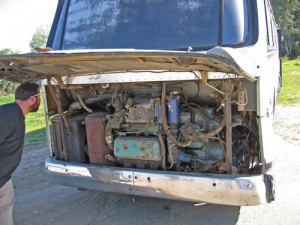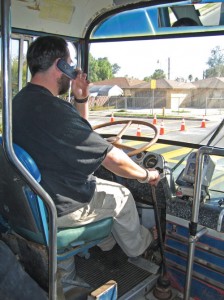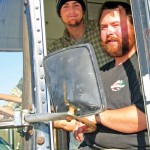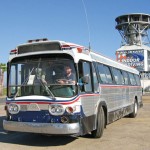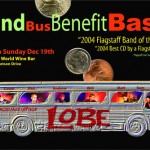By Greg Brown
“Good news, Dad! We put money down on a band bus. Now we’re set for the Seattle tour!” It was my son, Hannis, whose jazz hip-hop band Lobe had been well received on tours throughout the West. Their climb to the top, however, had been hampered by geography. It’s a long way to anywhere from Flagstaff, Ariz.
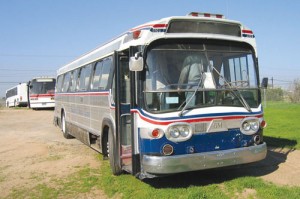
The band’s dream machine awaited us, in a yard full of derelict buses. Note the missing spare tire cover and floppy rear engine panel.
Lobe’s touring, until now, had been accomplished by car caravan. Along the way, band members camped or bunked with friends. This new tour bus would transport musicians and equipment in a single vehicle, and provide sleeping quarters when necessary. But tour buses are costly. I wondered how the band could afford one.
“Congratulations!” I said to my son with forced enthusiasm. “What sort of bus is it?”
“I don’t know the details, Dad. Matt and Phil found it in California. The next few Lobe gigs should pay the balance, and then we’ll pick it up.”
“Sounds great, Hannis. How much is this bus, anyway?”
“Two thousand dollars.”
“For the down payment?”
“No, for the whole bus.”
I was astonished. It’s tough enough finding a reliable used car for $2,000, much less something to haul seven musicians, plus equipment and hangers-on across the country. I couldn’t imagine a happy ending to this story. But such is the optimism of youth.
“Can the band afford to operate such a vehicle?” I asked in my most diplomatic tone. After all, these are adults and they hadn’t asked my opinion.
“Sure, we’ll convert the bus to bio-diesel and run it on filtered cooking oil. We’re already collecting jugs of free grease from nearby restaurants.”
I’d seen this conversion on smaller vehicles—the exhaust smells like a deep fryer—but couldn’t fathom the implications for a bus. I pictured stranded musicians, begging quarts of cooking oil from roadside restaurants to fill their 80-gallon tank. Such concerns, however, were quickly displaced by memories of my own youthful “bus”—a Corvair van purchased, unbeknownst to my parents, with a high school buddy. We’d invested countless hours resuscitating the decrepit vehicle, only to hitchhike home, penniless, when the engine blew near Princeton, Ill.
What was then a painful loss, however, is now a treasured memory worth at least $2,000. I resolved to squelch my skepticism while the bus deal played out. Weeks passed, and I forgot about it.
Then came a late-night phone call. The caller ID said “Barstow, California.” It was Hannis.
“Dad, I need some advice,” he said. “I drove Matt and Phil out here to pick up the bus, and already it’s broken down.”
“Where is it?”
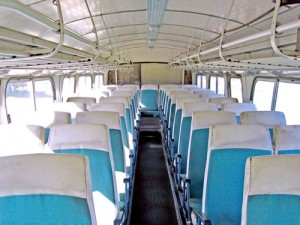
Rows of brittle benches lined the battered 45-passenger vehicle, last used as a Wyoming mine shuttle.
“On the shoulder of Interstate 40. Matt stalled the bus while shifting gears and can’t start it again. What’s more, the seller isn’t answering his phone. Where should we get help at this time of night? And what would it cost?”
“That’s a good question.” I said. “What kind of bus is this, anyway?”
“It’s a ’61 ‘Greyhound.'”
I gulped, and then visited my truck-driver neighbor for advice.
“Have they ever driven a big rig before?” asked Tom, chuckling. “The transmissions have no synchro.”
He detailed the requisite skills of double-clutching and clutchless shifting.
“Wait until morning to request a service call,” he said. “That’ll run about 80 bucks. But whatever the kids do, tell ’em not to tow it, because that’ll cost a fortune.”
I shared Tom’s counsel with my son, and suggested he notify the state police of the whereabouts of the bus.
“Now if I can just convince the guys to spring for a hotel room” said Hannis, wondering if the proud new bus owners could afford it.
“Guess what,” I informed my wife after hanging up. “The adventures of parenthood never end.”
After no news for two nail-biting days, I called my son back. To my relief he was back in Flagstaff.
“Where’s the bus?” I asked.
“It’s back at the seller’s. We had it towed.”
I winced. “What did that cost?”
“Five hundred dollars,” he said, after a pause. “We charged it to Matt’s credit card.”
Hannis felt the breakdown might be due to his friend’s lack of bus-driving experience. “Matt couldn’t shift above second gear,” he said, “meaning our maximum speed on the interstate was 12 mph. Here I was, running interference behind the bus, at night, in my little black Toyota; I thought we’d all get killed. Anyway, the seller wants $100 a month to store the bus, so we need to retrieve it immediately. I work this week and can’t drive eight hours each way to pick it up. Would you fly the guys to California if we find someone to drive it back?”
“Sure,” I said. “But what if it breaks down again, and they have no car?”
“You could always circle the bus on its way back, like a vulture,” he quipped. “Seriously, that’s up to Matt and Phil. They’re handling this.”
Two days later, I winged westward in the Flying Carpet, joined by Phil, Lobe’s sax player, and Kelly, “a friend of a friend.” Kelly claimed truck-driving experience, and carried as credentials the dirt under his fingernails and two small but impressively heavy toolboxes. Both young men had previously ridden in light planes—Phil with his dad, and Kelly as a summer fly-fishing guide on Alaska’s Kenai Peninsula. Our cockpit filled with lively conversation about airplanes, the band bus and Lobe’s latest album. By the time we crossed the Colorado River, I felt for these guys.
“Aren’t you worried about getting stranded driving the bus home?” I asked, noting the men’s lack of luggage.
“I am now,” said Kelly, upon learning from Phil that there’d been no pre-buy inspection by a mechanic.
Leaving the desert sands of eastern California, we cleared high mountains near Palm Springs and plummeted for landing at Perris Valley Airport. I radioed ahead to coordinate arrival with the field’s busy skydiving operation. Parachutists swirled around the Flying Carpet on rollout, while Twin Otters and a bulbous Shorts SkyVan toted additional jumpers aloft. More soon-to-be skydivers milled around the adjacent jump complex with its swimming pool, restaurant and pro shop. Alongside the runway, a DC-9 awaited conversion for mass parachuting. Towering over it all was a vertical wind tunnel, where skydivers hone their freefall technique.
The bus seller soon arrived. A gruff man of few words, he drove us to a yard full of derelict buses. There waited Lobe’s dream machine, a peeling and battered 45-passenger GM diesel, last used as a Wyoming mine shuttle. One headlight and the spare tire cover had been victims of the recent towing fiasco, while renegade body panels flopped loosely near the engine. Inside were rows of brittle benches. The seller started the bus, backed it into the road, and brusquely walked away.
Without further guidance, Kelly, Phil and I climbed aboard. Kelly took the driver’s seat, and with magnificent crunching and grinding, gingerly selected first gear. Second gear came easily, but mastering third and fourth took longer.
“The speedometer doesn’t work,” said Kelly. “Not sure about the windshield wipers, either. And I wish the seller had shown me how he started this thing. Hey, where’s the fuel gauge?”
“It’s at the rear of the bus by the fuel filler cap, but I’m not sure it works,” said Phil.
The engine ran smoothly, however, and already we were exceeding the previously attained 12 mph. When Kelly answered his cell phone, while still successfully negotiating gears, I felt my first glimmer of hope that these guys might actually conquer the 450 miles to Flagstaff. Back at the airport, we paused for photos in front of the skydiving wind tunnel. Then, with a lump in my throat, I waved goodbye as my friends disappeared in a puff of diesel smoke.
Homeward bound in the Flying Carpet, I peered down at Interstate 10, the very road Phil and Kelly would drive. My journey to Phoenix would take two hours; with luck, theirs would take eight. Periodically, I calculated their progress, assuming the bus was still running, and imagined their situation if it wasn’t. Palm Springs would offer haven, and many miles later, Blythe, Calif. But there’d be little else until reaching Phoenix. Remembering Hannis’ vulture joke, I resisted the urge to circle back and look for them.
Not until the 10 o’clock news that evening did our phone finally ring. Cringing, I answered.
“We’re in Phoenix!” said Phil. “The bus is running fine, so we’ll collect my car from the airport and continue on to Flagstaff.”
That would be an uphill, mountainous drive, but having made it this far, the old bus was nearing its new home. I went to bed worry-free, but the story wasn’t over.
Without a working fuel gauge, the bus apparently ran dry near midnight and coasted downhill to the Cordes Junction exit. Phil retrieved fuel in his car, but Kelly couldn’t restart the vehicle until investing $50 for a mechanic to re-prime the diesel engine. At 7 a.m. the next morning, the Lobe Tour Bus motored triumphantly into Flagstaff, 16 hours after leaving Perris, Calif. By suppertime, band members were already tearing out seats in preparation for the big Seattle tour.
It might be a tough road, but never underestimate the power of youthful enthusiasm in fueling a band and a bus—one way or another they’ll make it. Reminds me of another young bus owner, who dreamed of becoming a pilot…
Author of numerous books and articles, Greg Brown is a columnist for “AOPA Flight Training” magazine. Read more of his tales in “Flying Carpet: The Soul of an Airplane,” available through your favorite bookstore, pilot shop, or online catalog, and visit [http://www.gregbrownflyingcarpet.com].
- Phil and Kelly prepare to embark on the long journey to Flagstaff.
- My new friends pull away from the airport toward home. The Perris Valley Skydiving wind tunnel is in the background.
- Lobe band members populate the bus in a fanciful fundraising poster.












